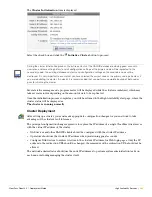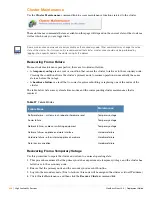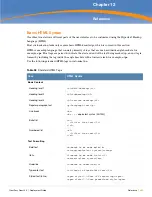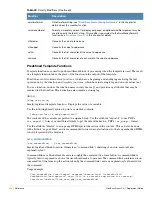
438
| High Availability Services
ClearPass Guest 3.9 | Deployment Guide
A similar procedure can be used to rebuild the cluster in the event of a secondary node suffering a hardware
failure.
Performing Scheduled Maintenance
Routine maintenance tasks such as a server reboot or shutdown may occasionally be required for a server
that is part of a cluster.
These tasks may be performed by ensuring that the server is the secondary node in the cluster. If the
secondary node goes offline, the primary node will be unaffected and the cluster will continue to provide
network services without interruption. When the secondary node comes back online, the cluster will be
automatically rebuilt and replication will resume.
To check the current status of a node, log into that node and click the
Show details
link displayed with
the cluster status on the High Availability page. The node’s current status is displayed under the
Local
Status
heading.
Use this procedure to make the current primary node the secondary node:
1. Log into the current secondary node of the cluster.
2. Click Cluster Maintenance, and then click the
Swap Primary Server
command link.
3. A progress meter is displayed while the primary node is switched. The cluster’s virtual IP address will be
temporarily unavailable while the swap takes place.
4. The swap is complete. The secondary node is now the new primary node for the cluster. The cluster is
back in a fault-tolerant mode of operation.
5. Perform any required maintenance on the new secondary node.
Updating Plugins
Plugins cannot be updated while High Availability is running. Because exact synchronization of the two
servers is required for High Availability Services, you must first destroy the cluster, then re-create the
cluster after the plugins are updated. See
Destroying a Cluster
and
Cluster Setup
in this chapter.
For information on updating plugins, see
Plugin Manager
in the
Administrator Tasks
chapter.
Destroying a Cluster
The
Destroy Cluster
command link is used to shut down a cluster and return to independent nodes. Avoid
using this command when you are accessing the cluster using its virtual IP address, as the virtual IP address
will no longer be available when the cluster has been destroyed.
Summary of Contents for ClearPass Guest 3.9
Page 1: ...ClearPass Guest 3 9 Deployment Guide ...
Page 32: ...32 Management Overview ClearPass Guest 3 9 Deployment Guide ...
Page 178: ...178 RADIUS Services ClearPass Guest 3 9 Deployment Guide ...
Page 316: ...316 Guest Management ClearPass Guest 3 9 Deployment Guide ...
Page 410: ...410 Administrator Tasks ClearPass Guest 3 9 Deployment Guide ...
Page 414: ...414 Administrator Tasks ClearPass Guest 3 9 Deployment Guide ...
Page 423: ...ClearPass Guest 3 9 Deployment Guide Hotspot Manager 423 ...
Page 440: ...440 High Availability Services ClearPass Guest 3 9 Deployment Guide ...
Page 518: ...518 Index ClearPass Guest 3 9 Deployment Guide ...
















































